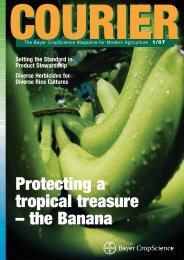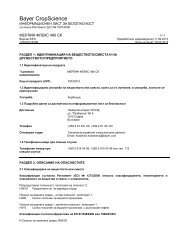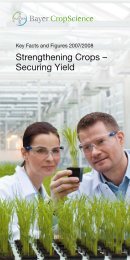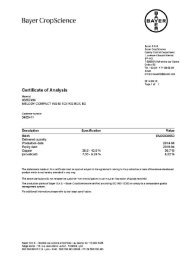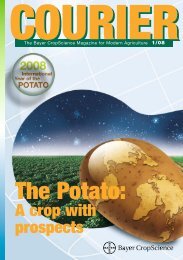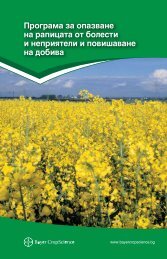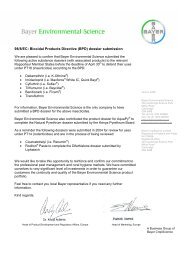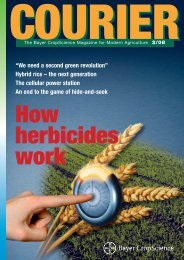For healthy potatoes - Bayer CropScience
For healthy potatoes - Bayer CropScience
For healthy potatoes - Bayer CropScience
Create successful ePaper yourself
Turn your PDF publications into a flip-book with our unique Google optimized e-Paper software.
pests are controlled, whilst their natural<br />
enemies remain unaffected.<br />
The use of diagnosis tools for monitoring<br />
pests and pathogen populations is a<br />
further important way of targeting treatment,<br />
allowing a limited – and localized –<br />
use of crop protection products.<br />
Avoiding resistance<br />
One of the most important aspects of the<br />
responsible use of crop protection products<br />
is the avoidance of resistance, which, if left<br />
to develop and spread, can allow the pest or<br />
pathogen to thrive even in treated crops.<br />
Resistance tends to develop wherever a<br />
high selection pressure is exerted on pests<br />
and pathogens through the frequent use of<br />
products from the same chemical class of<br />
activity. As compounds within the same<br />
class are often sold by different companies,<br />
resistance management has to be achieved<br />
through an industry cooperation. Thus<br />
three Resistance Action Committees –<br />
IRAC, FRAC and HRAC (I, F and H stand<br />
for insecticide, fungicide and herbicide,<br />
respectively) – operate under the umbrella<br />
of CropLife International. These committees<br />
have developed technical guidelines,<br />
among the recommendations of which is to<br />
rotate products within a crop spray programme.<br />
Resistance-development is a serious,<br />
but ultimately manageable, issue. It tends<br />
to occur most commonly in areas where a<br />
particular product is used too often, or<br />
even indiscriminately. Therefore, preventing<br />
resistance development protects biodiversity<br />
– in so far as an excessive use of<br />
crop protection products is avoided.<br />
The crop protection industry and farmers<br />
have learned their lessons: new<br />
approaches in research and development,<br />
combined with good management practices,<br />
now ensure that resistance is generally<br />
avoided, so that useful products can<br />
continue to serve their purpose over a prolonged<br />
period.<br />
Summary<br />
Although there aren’t any easy solutions to<br />
the problem of maintaining a balance<br />
between efficient agricultural production<br />
and the protection of biodiversity, much is<br />
being done to achieve this end. Recognition<br />
of our common responsibilities and<br />
the co-operation of all stakeholders are<br />
necessary if we are to preserve the natural<br />
resources that underlie both the integrity of<br />
ecosystems, and the well-being of mankind.<br />
<strong>Bayer</strong> <strong>CropScience</strong> is showing its<br />
commitment by taking measures during its<br />
research and development activities to<br />
ensure that biodiversity is preserved. We<br />
also co-operate in the development of<br />
locally-tailored technologies and services<br />
towards an integrated, responsible<br />
approach to the use of crop protection<br />
products. ■<br />
Annik Dollacker,<br />
<strong>Bayer</strong> <strong>CropScience</strong> AG, Germany





